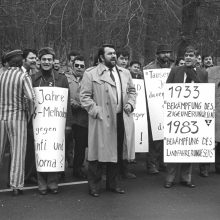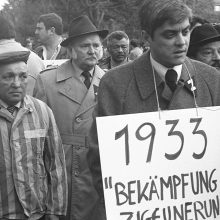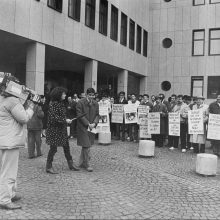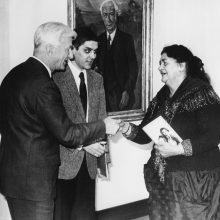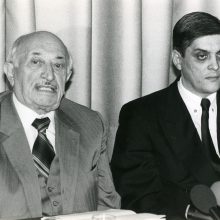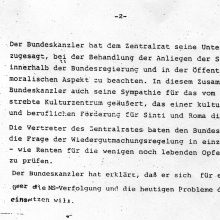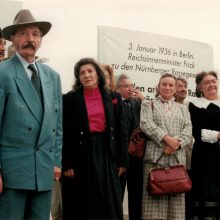The Central Council of German Sinti and Roma
The Central Council of German Sinti and Roma was established as an umbrella organisation with headquarters in Heidelberg in February 1982. It has since represented the interests of the Sinti and Roma living in Germany at both the national and the international level.
Initially, most of its political work revolved around combating the enduring caricature of the ‘gypsy’ and establishing the terms ‘Sinti’ and ‘Roma’ as self-designated names. The Central Council protested against the racist and discriminatory registration of the minority by police authorities and successfully campaigned for a review of a compensation practice that had previously discriminated against the Sinti and Roma. In May 1995 the Central Council was successful in gaining legal recognition for the German Sinti and Roma as a national minority.
01 | 17 March 1982 marked a turning point in the civil rights movement. The Central Council of German Sinti and Roma had only just been established and its delegation was welcomed by the then Federal Chancellor Helmut Schmidt, who officially recognised the genocide perpetrated on the Sinti and Roma ‘on racial grounds’. Documentation Centre […]
01
02.1 | Press release from the German federal government Documentation Centre Archives
02.1
02.2 | Press release from the German federal government Documentation Centre Archives
02.2
03.1 | Demonstration in front of the Federal Criminal Police Office in Wiesbaden in protest at the discriminatory registration of Sinti and Roma by the police, 28 January 1983. The 250 or so demonstrators then marched through the city centre of Wiesbaden to the seat of the Hessen Interior Minister, who was chairman of the […]
03.1
03.2 | Demonstration in front of the Federal Criminal Police Office in Wiesbaden in protest at the discriminatory registration of Sinti and Roma by the police, 28 January 1983. The 250 or so demonstrators then marched through the city centre of Wiesbaden to the seat of the Hessen Interior Minister, who was chairman of the […]
03.2
03.4 | Demonstration in front of the Federal Criminal Police Office in Wiesbaden in protest at the discriminatory registration of Sinti and Roma by the police, 28 January 1983. The 250 or so demonstrators then marched through the city centre of Wiesbaden to the seat of the Hessen Interior Minister, who was chairman of the […]
03.4
04 | Demonstration in front of the regional administration in Cologne in March 1985. It was staged in protest at a compensation practice that massively discriminated against the Sinti and Roma. The Central Council of German Sinti and Roma was able to obtain new rulings for several thousand survivors whose compensation claims had previously been […]
04
05 | First remembrance ceremony organised by the Central Council of German Sinti and Roma on the grounds of the former ‘gypsy camp’ at Auschwitz-Birkenau, October 1985 Documentation Centre Archives
05
06 | Willy Brandt welcoming a delegation of the Central Council at the German Social Democratic Party’s Ollenhauer-Haus in Bonn (October 1985). Documentation Centre Archives
06
07 | Federal President Richard von Weizsäcker receiving a delegation of the Central Council of German Sinti and Roma (7 November 1985); among them, the Holocaust survivors Hildegard Lagrene (centre) and Herbert Birkenfelder (right). Photo No. 02261718: dpa/Süddeutsche Zeitung Photo
07
08 | Romani Rose and the two deputy chairmen of the Central Council, Wilhelm Spindler and Anton Franz, at a private audience with Pope John Paul II in the Vatican on 16 May 1986. The Pope expressed his ‘moral support’ for the Central Council’s efforts aimed at improving the situation of the Roma in various […]
08
09 | The first memorial service commemorating the Sinti and Roma murdered by the Nazis was held at Speyer Cathedral in March 1988. From left to right: Romani Rose, Bishop Anton Schlembach (Bishop of Speyer), Bernhard Vogel (Minister President of Rhineland-Palatinate), Rita Süssmuth (Federal Minister of Family Affairs, Senior Citizens, Women and Youth), and Hans-Jochen […]
09
10 | Simon Wiesenthal supported the Central Council of German Sinti and Roma with great personal commitment for many years. The photo shows him at a press conference with Romani Rose in Frankfurt in March 1990. Documentation Centre Archives
10
11.1 | Remembrance ceremony organised by the Central Council of German Sinti and Roma in front of the Brandenburg Gate in September 1992 on the occasion of the 50th anniversary of the Himmler-Thierack agreement aimed at ‘annihilation through work’. The ceremony was also attended by fifty Holocaust survivors. Standing at the lectern is Romani Rose. […]
11.1
11.2 | Survivors of concentration and extermination camps at the remembrance ceremony Documentation Centre Archives
11.2
11.3 | Address by Otto Rosenberg, Auschwitz survivor and chairman of the Berlin-Brandenburg State Association of German Sinti and Roma Documentation Centre Archives
11.3

